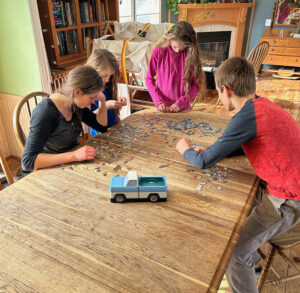
It’s that time of year–when we’re not quite ready to give up our garden bounty, but Mother Nature has other ideas. How to bridge the gap? Cold frames! Lehman’s organic gardener, Karen Geiser, uses them at both ends of the growing season, and gets great crops of hardy things like peas, lettuces, beets, carrots, kale, spinach and Swiss chard.

At a recent seminar at Karen’s Garden Delights Farm, Geiser introduced the theories behind cold framing, and presented some easy and efficient ways to add them to your garden’s plan. “I was reading Eliot Coleman’s Four Season Harvest when we were starting here, and I knew it was exactly what we needed. I feed my family from the same garden that I sell from, and I realized that I could really make a difference by keeping fresh things in our diets all year long, and I could do it organically.”
She discusses how Coleman’s ideas for growing year-round in Maine translate well to Amish Country, Ohio, and why it makes sense for many cold weather regions. When you garden in the winter, she says, you create so many advantages:
- You save money (less grocery store produce purchased)
- Produce tastes better because it is fresher
- Virtually bug-free–but not pest-free (watch out for mice, rabbits and deer)
- Adds to your food security stores–you can grow enough to preserve
- Keeps the gardening junkie happy (Geiser laughs here)
- Good for you–keeping that spiritual connection with the earth and your food

The beginning of the cold season really slows down the growth of plants, she noted. “No matter what you use for a cold frame, you need to keep that in mind. So start planting your colder weather crops as soon as you’ve harvested the warm weather ones.”
In her hoop house, for instance, she keeps crops in constant rotation through the summer, finishing with the hardier winter crops that will supply her table through the cold months. “Now, you’ll get warmer days in October, sometimes in November, so you want to make sure you can vent the cold frame to avoid frying your spinach!”
The cold frame itself isn’t as complicated as folks seem to think, says Geiser. “You can use almost anything that will give shelter and admit light. Remember, your cold weather crops are hardy, and were developed in places that had a lower than average temperature. You don’t have to buy a big fancy system. Look around, and see what you can salvage or scavenge for the cold frame section of your garden.”

Geiser shows a couple of translucent barrels that are cut in half longways, top to bottom. “If you use a barrel, for instance, you want one that’s contained food, or is food-safe. Clean them, cut them, and you’re all set.” She uses her barrels directly over spinach, chard, radishes and other cold-hardy greens. “We use an old trampoline frame too, that someone was junking. It’s great! Covers go over it easily, and it’s simple to move. Like the hoop house, we take the cover off for summer crops, and put it back on for colder weather crops.” She strongly recommends using garden tunnels and plastics designed for coverings. It’s worth the investment, as it’s more durable. She also points out the cardboard ‘paths’ run through the garden. “We can use these to get to each crop bed easily, and it certainly keeps the weeds down.”
As the group takes a twilight tour of the garden, Geiser continues to help brainstorm ideas for building all sizes of cold frames. “Take a look at Craigslist, or Freecycle. You can find folks looking to get rid of all kinds of things. With old window frames, glass and sashes, you can build a small cold frame. Just remember to build in a venting system, no matter what kind you end up building. Like I said, you don’t want to cook your plants before you get them to the table.”

She notes that she’s harvesting fresh spinach, kale and other leafy greens year round, and the cold frames give her the ability to start spring crops much earlier too. “Cold frames are very simple to make and use, and they give your garden so much more productivity per foot. Every serious gardener should use them.”
Check out Karen’s article on cold framing for more information.

































[…] months. “Now, you'll get warmer days in October, … … Here is the original post: Cold Framing With The Expert | Lehman's Country Life ← Discover the Treasure of Health From Organic Garden – Other 5 Tips From […]